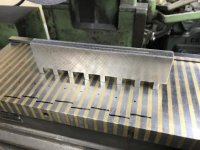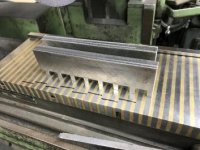I’m wondering if anybody else has made a set of these before? And how efficient are they?
About 25 years ago I made a set, but I never got to use them. The grinding hand got me to make them when I was a apprentice. The grinding hand used them about once a month, that I saw.
I have a 30 pole magnet on my surface grinder.
I was thinking of making them from 4140 annealed and leaving them soft. About 2 1/4” tall.
I do have an 18 inch magnet with 23 inches of stroke. I figure the longer they are, the more powerful they will be.
I do have a custom job that needs custom height. Initially I am thinking of making them 10 inches long and maybe in the future making some 24 inches long.
About 25 years ago I made a set, but I never got to use them. The grinding hand got me to make them when I was a apprentice. The grinding hand used them about once a month, that I saw.
I have a 30 pole magnet on my surface grinder.
I was thinking of making them from 4140 annealed and leaving them soft. About 2 1/4” tall.
I do have an 18 inch magnet with 23 inches of stroke. I figure the longer they are, the more powerful they will be.
I do have a custom job that needs custom height. Initially I am thinking of making them 10 inches long and maybe in the future making some 24 inches long.









